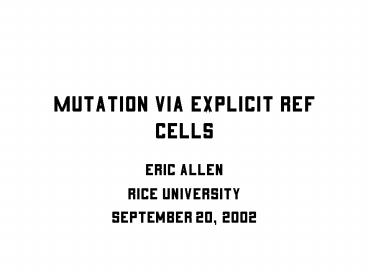Mutation via Explicit Ref Cells PowerPoint PPT Presentation
1 / 17
Title: Mutation via Explicit Ref Cells
1
Mutation via Explicit Ref Cells
- Eric Allen
- Rice University
- September 20, 2002
2
Mutation via Implicit Boxing
- Requires modification of environment
implementation - Requires modification of variable binding
- Requires modification of variable lookup
3
Mutation via Explicit Boxing
- (ref M), which creates a ref cell
- (! M), which assumes that M will evaluate to a
ref cell - ( M1 M2) which replaces the contents of that M1
with the value M2 reduces to.
4
Evaluating Ref Cells
- ((ref? M)
- (box (MEval (ref-init M) env)))
5
Evaluating !
- ((!? M)
- (unbox (MEval (!-expr M) env)))
6
Evaluating
- ((? M)
- (set-box! (MEval (-lhs M) env)
- (MEval (-rhs M) env))
7
Advantages of Explicit Boxing
- Orthogonal design None of the existing code was
modified - Programmers are made more aware of a decision to
use mutation - Can simulate call-by-reference through explicit
boxing
8
Disadvantages of Explicit Boxing
- Programming language becomes more complex
- Programming language becomes wordier
- Semantics may not be as intuitive
9
Minimizing Mutation
- As weve shown, adding mutation to a language
strongly impacts the complexity of the language - For this same reason, using mutation in a program
quickly increases the complexity of the program
10
Values in Algol-like Languages
- In Scheme, ML, Java, etc., mutable objects are
values - In Algol, C, C, etc., values are immutable!
- Pass-by-value creates copies. How to share?
11
Values in Algol-like Languages
- Share with passed pointers
- Pointers are passed-by-value (like ints)
- Dereferencing pointers allows sharing
- How are pointers different than boxes?
12
Modeling Mutation Mathematically
- Both means of modeling mutation weve discussed
rely on mutation themselves - Why might we want to understand mutation through
a purely functional world? - How can we understand mutation in such a world?
13
Attempt 1
- Construct a new environment, and pass recursively
to interpreter - In this new environment, bind variables to their
new values - Why doesnt this approach work?
14
Attempt 2
- Let Meval return closures instead of values
- Then environments can be passed to the calling
contexts - Sharing is not modeled! Consider closures with
references to the shared data.
15
Solution
- Introduce two environments
- A location environment maps variables to
locations (boxes) - A store maps locations to values (an abstracted
form of a machine memory)
16
Sharing
- A location environment captures sharing by
mapping multiple variable to the same location - New locations must be generated when new data is
allocated - In the purely functional world, this last step
requires explicitly passing a stream
17
Sharing
- The store and location environment must be passed
to MEval - The store and location environment must be passed
to all subfunctions that refer to the environment

